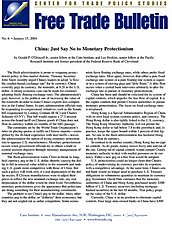The constraints set by the World Trade Organization’s rules on placing quotas or tariffs on Chinese imports-exemplified by the ill-fated experience with steel tariffs-leaves the administration the option of trying monetary protectionism to appease U.S. manufacturers. Monetary protectionism occurs when government officials try to obtain a trade or current account objective through monetary manipulation of nominal exchange rates.
The Bush administration wants China to break its long-held currency peg to the U.S. dollar, thereby causing the dollar to fall in nominal value relative to the renminbi and making U.S. goods more competitive with those of China. But such a policy will work only if a real depreciation of the dollar occurs. If Chinese manufacturers were to adjust their prices to reflect the new nominal exchange rate, any real depreciation of the dollar would be short-lived. Nevertheless, monetary protectionism gives the appearance that politicians are doing something for their manufacturing constituents.
The problem is not China’s peg to the dollar. Many other countries peg to the dollar, or “dollarize” their economies, but they are not singled out as unfair competitors. Some economists favor floating exchange rates, while others prefer fixed exchange rates. Most agree, however, that either a pure fixed exchange rate system or a pure floating rate system is superior to a system of moving pegs and “dirty floats.” A dirty float occurs when a central bank intervenes arbitrarily to alter the exchange rate in pursuit of monetary protectionism.[1]
China has been and should be criticized for its system of capital controls, which impedes the free flow of capital. It is the capital controls that permit Chinese authorities to pursue monetary protectionism. The focus on fixed exchange rates is misplaced.
Hong Kong is a Special Administrative Region of China with its own legal system, customs policy, and currency. The Hong Kong dollar is also tightly linked to the U.S. currency. The Hong Kong Monetary Authority will not permit the Hong Kong dollar to fall below 7.8 to the greenback and, in practice, keeps the upper bound within 1 percent of that figure. No one in the Bush administration has hectored Hong Kong to float its currency.
In contrast to its mother country, Hong Kong has no capital controls. As do goods, money moves freely into and out of the city. Getting rid of capital controls would compel China’s monetary authority to deal with market pressures on its currency. Either a new peg or a free float would be adopted.
U.S. protectionists could no longer claim that China’s policy of undervaluing its currency provides its exporters with a competitive advantage. At the same time, China’s central bank would no longer need to purchase U.S. Treasury obligations in voluminous quantities to maintain its currency peg. Economist David Hale estimates that the monetary authorities of China and Hong Kong purchased nearly $100 billion of U.S. Treasury securities (including mortgage-backed securities) in the last 18 months. That policy props up the value of the U.S. dollar.
Currently, China is in no position to eliminate capital controls. Four large state-owned banks in China have $300 billion to $400 billion of nonperforming loans. Cleaning up those loans would force state-owned enterprises (SOEs) to rationalize and downsize. SOEs, the major borrowers, still employ more than two-thirds of the labor force. The unemployment resulting from their sudden restructuring could lead to social upheaval and a political crisis.
China in crisis is not the Bush administration’s goal, so it will not press on the real economic issue. Calling for China to float its currency is political rhetoric to salve U.S. domestic political wounds, not serious international economic policy. Under its WTO accession agreement, China committed to open its financial markets. Overall, China is living up to that agreement. Freer movement of capital will follow. Then China’s leaders can decide whether to adopt a new peg or float the currency.
The monetary experience in Hong Kong confirms that a monetary authority can maintain a peg if it forgoes monetary sovereignty. With a peg, changes in the domestic money supply are triggered by change in international reserves. The monetary authority cannot guarantee domestic price stability with such a monetary system. Hong Kong has suffered price deflation for about five years. Because of the economy’s flexibility, the dislocations caused by that deflation have been less severe than they would have been in many other countries.
It is doubtful, however, that Mainland China would choose such a system for the long run. Perhaps after one or more revaluations, China will float its currency. The question will then be whether to adopt a free or a dirty float.
An open trading and investment relationship between China and the United States would benefit the citizens of both countries. China’s leaders need to move away from protectionism in all forms. President Bush should demonstrate leadership by not advocating further protectionism, including the monetary variety.
[1] For a fuller discussion of monetary protectionism, see W. Lee Hoskins and Owen F. Humpage, “Avoiding Monetary Protectionism: The Role of Policy Coordination,” Cato Journal 10, no. 2 (Fall 1990): 541–55.

